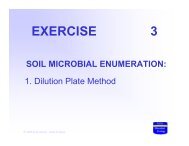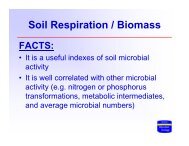Soil Microbial Ecology - Soil Molecular Ecology Laboratory
Soil Microbial Ecology - Soil Molecular Ecology Laboratory
Soil Microbial Ecology - Soil Molecular Ecology Laboratory
Create successful ePaper yourself
Turn your PDF publications into a flip-book with our unique Google optimized e-Paper software.
Page 13<br />
hold a certain volume of soil. This total count method of cell quantification is very rapid<br />
but has the problem of requiring high cell concentrations (e.g. 10 7 / ml), and may include<br />
dead and living cells with equal probability.<br />
B. INDIRECT COUNT CELL NUMBERS (ESTIMATION):<br />
Cell biological activity can be used to estimate cell numbers. Such method is often<br />
preferable either for convenience or because direct counting is difficult or even<br />
impossible in many situations (for example, when quantifying filamentous organisms).<br />
Estimates of cell number include determinations of turbidity, metabolic activity, or dry<br />
mass.<br />
1. TURBIDITY<br />
The cloudiness or turbidity of a culture is caused by the individual cells scattering light.<br />
Degree of turbidity is a direct correlation of cell mass. The average cell mass of<br />
individual cells in a culture must first be determined if the turbidity of a culture is to be<br />
used to estimate cell count. This standardization works best for cultures in the<br />
exponential growth phase.<br />
2. METABOLIC ACTIVITY<br />
The metabolic output or input of a culture may be used to estimate viable count. This<br />
method has the same qualification as turbidity methods. The rate at which metabolic<br />
products such as gases and/or acids are formed by culture reflects the mass of bacteria<br />
present. The rate at which a substrate such as glucose or oxygen is used up also reflects<br />
cell mass. <strong>Soil</strong> enzymes, soil DNA, and soil respiration are some of the widely used<br />
techniques in estimating soil activities.<br />
3. DRY MASS<br />
Determinations of dry mass required to dry cultures before analyses. It is also required to<br />
separate cells from medium by some physical means such as filtration or centrifugation.<br />
The cells are then dried, and the resulting mass is weighed. For filamentous organisms<br />
such as fungi, the method works sufficiently well compared to other methods listed that<br />
dry mass determination is frequently employed.





